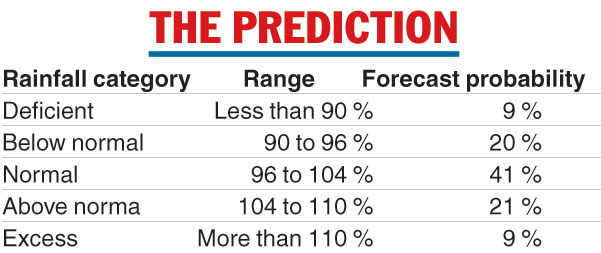India is likely to receive normal rainfall this monsoon, the national weather agency said on Wednesday, delivering its first long-range forecast for 2020 amid concerns about the impact of the coronavirus pandemic on the economy.
The India Meteorological Department (IMD) said rainfall was likely to be 100 per cent of the long period average, which for the country as a whole is 88cm. The forecasts also predict a 41 per cent probability of normal rainfall and 21 per cent probability of above normal rainfall.
The IMD has also changed the monsoon onset and withdrawal dates for locations across the country, saying the revisions are based on the rainfall trends since the 1960s while the earlier dates were based on trends from 1900 to 1940.
Senior IMD scientists said their forecast was based on a statistical model that relied on distant weather parameters, including sea surface temperatures in the Pacific Ocean, and on computer simulations of the weather expected during the four-month monsoon season starting June 1.
“We’re watching sea surface temperatures in the east-central Pacific Ocean that are known to strongly influence the Indian monsoon,” said Madhavan Rajeevan, a senior meteorologist and secretary in the earth sciences ministry.

A slight rise in Pacific sea surface temperatures — a phenomenon called El Nino — has been linked to poor monsoon performance, while a slight dip in the sea surface temperatures, known as La Nina, can boost rainfall over India.
“As of now, neutral (temperature) conditions are prevailing in the Pacific Ocean,” Rajeevan said. Some climate simulations suggest that these conditions are likely to persist during the monsoon.
However, some climate models also point to the possible emergence of La Nina conditions — favourable for the monsoon — during the second half of the wet season.
The IMD will deliver an updated long-range monsoon forecast in the first week of June, Rajeevan said.
Under the revised onset and withdrawal dates, the onset date remains June 1 for Thiruvananthapuram but has changed from June 10 to June 11 for Calcutta, June 23 to June 27 for Delhi, and from June 21 to June 30 for Bhuj.
The new withdrawal dates are October 12 instead of October 14 for Calcutta, September 26 instead of September 16 for Bhuj, October 8 instead of September 29 for Mumbai, and September 25 instead of September 29 for Delhi.










